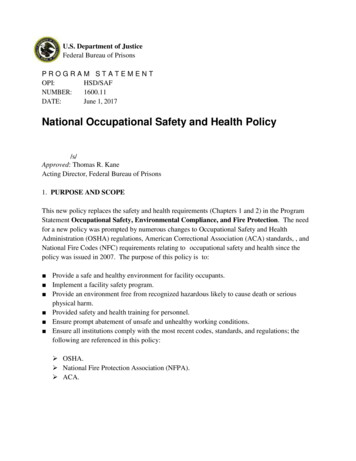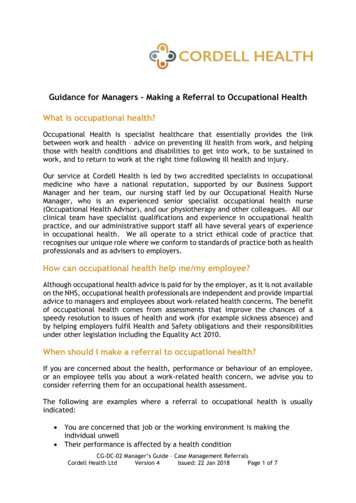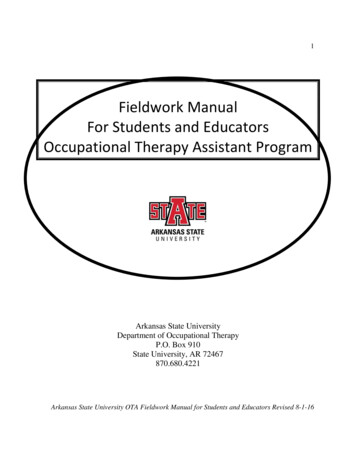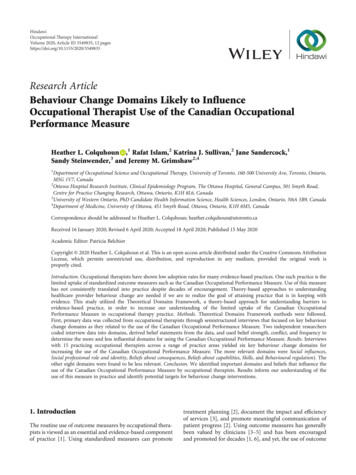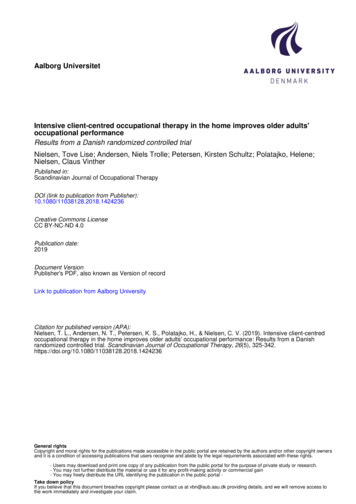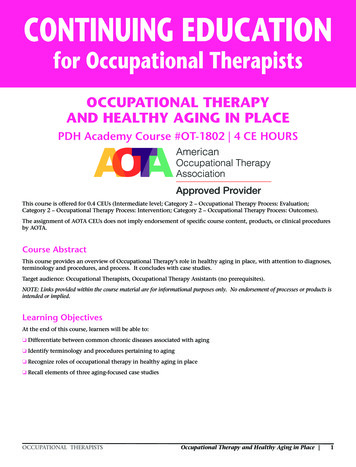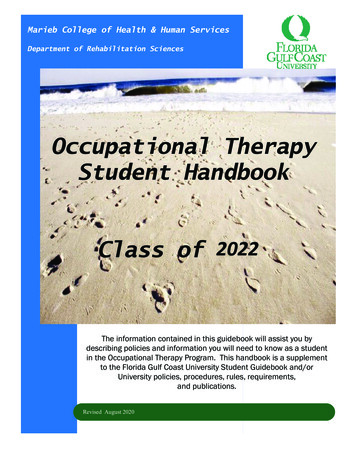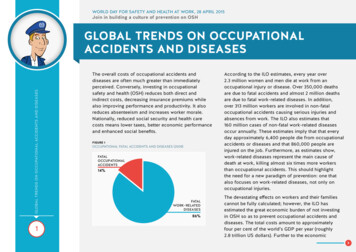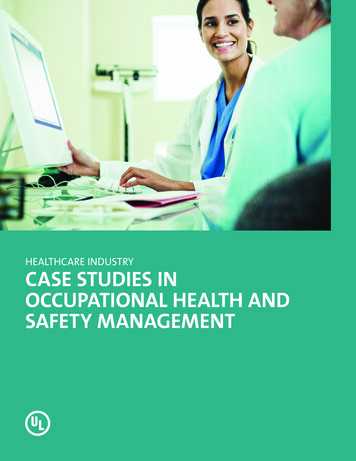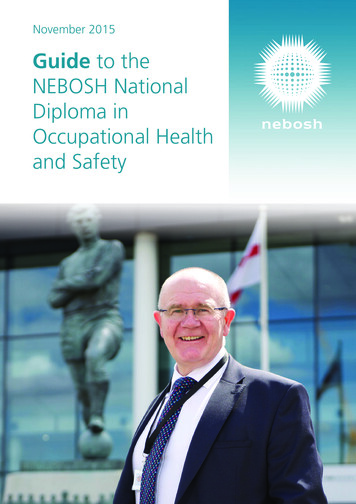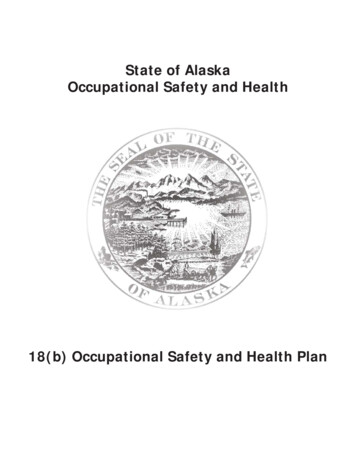
Transcription
State of AlaskaOccupational Safety and Health18(b) Occupational Safety and Health Plan
18 (B) OCCUPATIONAL SAFETY AND HEALTH PLANFOR THE STATE OF ALASKATABLE OF CONTENTS1.2.3.PREFACE . 1INTRODUCTION . 1A. Purpose . 1B. Scope of Plan . 1Exclusions . 2C. Authority . 2D. Definitions . 2PLAN NARRATIVE . 3A. Legal Authority . 3( 1) Enabling Legislation and Amendments . 3( 2) Governor’s Support . 3( 3) Designation of Agency and Authority . 3( 4) Department of Law Determination . 4( 5) Department of Labor . 4( 6) Commissioner of Labor . 4( 7) Director, Division of Labor Standards & Safety . 4( 8) Final Approval / Determination of Alaska State Plan . 4( 9) Jurisdiction . 5(10) Agreements with other Agencies. 5(11) Public Information and Disclosure . 5(12) Coverage of Public Employees . 5B. Regulations and Standards . 5(1) Inspections . 5(2) Recordkeeping . 6(3) Variance (Application and Procedures) . 6(4) Appeals . 6(5) Discrimination . 7(6) Standards . 8(a) State must be at least as effective . 8(b) State provides adequate method to ensure (a) . 8(c) State plan for promulgation of standards . 8(d) Emergency Standards promulgation. 9(e) State standards for informing employees . 9(f) State standards on hazard exposure. 9(7) State Regulations and Standards . 9(a) State Regulations . 9(b) State Occupational Safety Standards . 9(8) Posting Requirements / State Poster . 10C. Enforcement Policy and Procedures . 10(1) Legal Authority . 10(2) At Least as Effective as OSHA Regulations . 10(3) Abatement . 10(4) Employer/Employee Responsibilities . 10(5) Employee Access to Information & Records . 11
D.E.F.G.(6) Inspection Programming Scheduling . 11(a) Programmed Inspection . 11(b) Unprogrammed Inspections. 11(i) Imminent Danger . 11(ii) Fatalty / Catastrophe Investigation . 12(iii) Employee Complaints . 12(iv) Referrals . 12(v) Follow up Inspections . 12(7) Inspection Procedures. 12(a) Prohibition against advanced notice . 13(b) Right of Entry & Inspection . 13(c) Employee Representative . 13(d) Restraining Order . 13(e) Trade Secrets . 13(f) Sanctions . 13(8) Compelling Compliance . 14(a) Authority . 14(b) Methods . 14(9) Informal Review . 15(10) Protection Against Discrimination . 15(11) Management Systems . 15(a) IMIS . 15(b) Internal Review . 15(c) Planning Systems . 15Voluntary Compliance . 16(1) Authority . 16(2) Training and Education (Employer/Employee). 16(a) Internal . 16(b) External. 16(3) Consultation. 16Personnel. 17(1) Affirmative Action . 17(2) Merit System Rules . 17(3) Adequately Trained Staff . 17(4) Organizational Chart . 17(5) Benchmark . 18Fiscal Resources . 18(1) Adequate State Funding (General Fund) . 18(2) 23(g) Federal Grant . 18(3) Bureau of Labor Statistic (BLS) Funding . 18(4) Fees and Other Consideration under 18 (b) . 18Operations and Procedure Manual . 18(1) Safety Operations Manual . 18(2) Technical Manual . 19(3) Integrated Management Information System (IMIS) Man. . 19(4) AKOSH Program Directives . 19(5) AKOSH Interpretation Memos. 19(6) Voluntary Compliance Manual . 19(7) Chemical Information Manual . 19
H. Records and Reports . 19(1) IMIS. 19(2) Participation in BLS Program . 19(3) Records/Reports Required by US Sec. Labor . 20(4) Records/Reports Required by State . 20(5) Records Retention and Disposal. 20(a) Compliance Inspection Files . 20(b) Consultation Visit Files . 20(c) Fatality and Accident Investigation Files . 20(d) Standards & Regulations Files . 20(e) Variance Files . 20(f) Subject & correspondence Files . 20(g) Compliance Manuals . 20I. State Plan Change Supplements . 20(1) Federal Initiated Changes . 20(2) State Initiated Changes . 21J. Federal Registers (Applicable to Plan) . 21K. State Programs with No Corresponding OSHA Program . 21(1) Explosives Handlers Certificate . 21(2) Asbestos Abatement Certificate . 21L. Laboratory Services. 22M. Appendices . . 22-23
THE OCCUPATIONAL SAFETY AND HEALTH PLANFOR THESTATE OF ALASKA1.PrefaceThe Williams-Steiger Occupational Safety and Health Act of 1970 charged the U.S.Department of Labor with the responsibility for establishing a program assuring “so far as possibleevery working man and woman in the nation, safe and healthful working conditions, and preservingour human resources.”Congress included in the Act of 1970, a provision, Section 18(b), under which “any statewhich, at any time, desires to assume responsibility for development and enforcement therein ofoccupational safety and health standards relating to any safety or health issue, shall submit a StatePlan.”On December 8, 1972, the Governor of the State of Alaska issued a letter of intent to supportstate legislation for the State to assume responsibility for the development of a state plan for theenforcement of safety and health standards within the state. The Governor designated the Alaska StateDepartment of Labor as the responsible agency to develop and administer the Alaska occupationalsafety and health program. The Commission of the Department of Labor was appointed as designee.The Commissioner exercises all the powers and performs all the duties prescribed for the occupationalsafety and health program established by state Plan agreement and criteria of 29 CFR 1902.4(b) and 29CFR 1902.4(c).2.IntroductionA. PurposeThe purpose of this Plan is to implement the provisions and intent of the Williams-SteigerOccupational Safety and Health Act of 1970, PL 91-596, 91st Congress, under Section 18(b)and (e) of the Act, which provides that any state may assume responsibility for the developmentand enforcement of occupational safety and health standards related to issues covered bycorresponding standards promulgated under Section 6 of the Act.B. Scope of PlanThe Alaska State Plan covers all occupational safety and health “issues” as defined in 29 CFR1902.2(c)(1), with the exception of the following worksites and industries:*Maritime employment (29CFR Part 1915, shipyard employment; Part 1917, marineterminals; Part 1918, longshoring; Part 1919, gear certification) as well as provisions ofthe general industry standards (29 CFR Part 1910) appropriate to hazards found in theseemployments.*Marine-related private sector employment at worksites on navigable waters such asfloating seafood processing plants, marine construction, employments on artificialislands and diving operations in accordance with section 4(b)(1) of the Federal Act.-1–
*Private sector worksites located within the Annette Islands Reserve of the MetlakatlaIndian Community and within the Mount McKinley National Park.*Federal agencies whose employees work for the United States.*Work sites where employees are protected by government agencies under the AtomicEnergy Act of 1954 (42 U.S.C. 2021).*Worksites where employee working conditions are regulated by Federal agencies otherthan the U.S. Department of Labor under the provisions of section 4(b)(1) of theOccupational Safety and Health Act of 1970 (84 Stat. 1527, 29 U.S.C. 653 (b)(1)).An “issue” is considered to be an industrial, occupational or hazard grouping which is at leastas comprehensive as a corresponding grouping for which OSHA has promulgated a regulation,standard or rule.The State Plan applies to all private and public employers and employees in all industries (seeexclusions above) subject to the jurisdiction of the Alaska Department of Labor pursuant toAlaska Statutes, Section 19.60.030(6) which gives the authority for it to establish and enforceoccupational safety and health standards that prescribe requirements for safe and healthfulworking conditions for all employment, including state and local government employment.C. AuthorityThis plan is developed under the terms of a written agreement between the State of Alaska andthe U.S. Department of Labor, by which the State of Alaska Department of Labor, as designee,filed notice of intent to submit a Developmental State plan by September 17, 1972.D. DefinitionsThe following terms are used in this document:“AKOSH” means the Alaska Occupational Safety and Health program.“Assistant Secretary” means the Assistant Secretary for Occupational Safety and Health,United States Department of Labor.“Commissioner” means the Commissioner of the Alaska Department of Labor.“Department” means the Alaska Department of Labor.“Director” means the Director of Labor Standards and Safety of the Alaska Department ofLabor.“Issue” means an occupational standard, code, regulation, rule, or statute for an industrial,occupational or hazard grouping.“OSHA” means the Federal Occupational Safety and Health Administration.-2–
“Secretary” means the Secretary of Labor, United States Department of Labor.3.Plan NarrativeA. Legal Authority(1) Enabling Legislation and Amendments: Legislation to support the Alaska StateOccupational Safety and Health Program (AKOSH) comparable to the FederalOccupational Safety and Health Act was enacted by the Alaska state Legislature in1973 as Senate Bill No. 46. The Bill was signed into law by Governor William Eganon April 25, 1973 and became effective on July 24, 1973. The legislation wasapproved by the United States Assistant Secretary of Labor for Occupational Safetyand Health on July 31 1973 with final approval appearing in the Federal Register onAugust 10, 1973.Since 1973 the Alaska Occupational Safety and Health Statutes have beenamended in 1976, 1982, 1983 and 1992. In 1976 provisions were added torequire that the Commissioner submit a news release to the electronic newsmedia in the state whenever the Commissioner promulgates any regulation orstandard, or grants any variance; to allow substitution of training in the safetyprinciples and codes and standards for up to three years of the five years ofexperience required for qualifications of safety inspectors; and to requireemployers to report within 24 hours after receipt of information that an accidentoccurred that is fatal to one or more employees. In 1982 an Executive Orderchanged the designation of the Division given the responsibility of carrying outthe Alaska Occupational Safety and Health program from Division ofOccupational Safety and Health to division of Labor Standards and Safety toreflect a reorganization that occurred in 1981. In 1983, provisions dealing withemployer’s responsibility to provide information and training on toxic andhazardous substances were added to the Statutes. In 1992, AS 18.60.085 andAS 18.60.095 were revised to increase by seven fold the maximum civilpenalties authorized under the Alaska OSH Statutes. This change was made inorder to bring Alaska’s OSH statutes into compliance with the Federal OSH Actwhich had been revised in November, 1990 by Omnibus Budget ReconciliationAct of 1990 to increase by seven fold OSHA penalties.(2) Governor’s Support. A letter of support was issued on December 8, 1972 byGovernor William A. Egan as required by 29 CFR 1902.2(b) for developmental stateplans where legislative changes are required. (See letter in Appendix A.1)(3) Designation of Agency and Authority. In a March 15, 1971 letter to J.D. Hodgson,Secretary of Labor of the United States Department of Labor, Governor William A.Egan, designated the Alaska Department of Labor as the state agency responsible fordeveloping and implementing an 18(b) (developmental) state plan conforming withthe Occupational Safety and Health Act (See Appendix A.2).Revised July, 1992-3–
(4) Department of Law Determination. In an opinion dated December 1972, fromAttorney General John E. Havelock to Department of Labor Commissioner Henry A.Benson, the Alaska Department of Law determined that the Act relating to theestablishment and enforcement of Occupational Health and Safety Standards does notconflict with the Alaska constitution or any law of the State of Alaska. (See AppendixA.3)(5) Department of Labor. The Department of Labor, under the Governor of the State ofAlaska consists of four divisions: an Administrative Services Division; EmploymentSecurity Division; Workers’ Compensation Division; and Labor Standards and SafetyDivision. The Alaska Occupational Safety and Health program is within the LaborStandards and Safety Division.(6) Commissioner of Labor. The Commissioner of Labor, appointed by the Governor, isresponsible under the State’s Occupational Safety and Health law to establish andenforce occupational safety and health standards that are at least as effective as thosepromulgated by the United States Secretary of Labor under Paragraph 6 of Public Law91-596; to require employers to maintain and submit injury and illness records andother records as necessary for the enforcement of the Alaska Occupational Safety andHealth Law; and to conduct studies and work with other agencies, organizations andinstrumentality’s to foster safety and health and reduce accidents.(7) Director, Division of Labor Standards and Safety. The Commissioner appoints theDirector of Labor Standards and Safety who shall have charge and supervision of theAlaska Occupational Safety and Health program. The director shall exercise all thepowers and perform all the duties prescribed for the Commissioner by law in relationto the enforcement, amendment, alteration, change, and making additions to the laws,regulations, statutes, and policies for the Alaska Occupational Safety and Healthprogram.(8) Final Approval/Determination of Alaska State Plan. Alaska received certification onSeptember 9, 1977 in accordance with 29 CFR 1902.34 that it had completed on orbefore October 1, 1976 all developmental steps specified in the plan as approved onJuly 31, 1973. On September 26, 1984, the Alaska plan was granted final approval inaccordance with section 18(e) of the Act and the procedures in 29 CFR 1902. OSHAgranted 18(e) certification after that State met the “fully effective” compliancebenchmark as established in 1980, and was satisfactorily providing reports to OSHAthrough participation in the Federal-State Unified Management Information System.Based on the evaluation Report for FY 1983 and available FY 1984 date, and afteropportunity for public comment and an informal public hearing held on June 7, 1984in Anchorage, Alaska, the Assistant Secretary determined that in actual operations, theState of Alaska Occupational Safety and Health program is at least as effective as theFederal program in providing safe and healthful employment and places ofemployment and meets the criteria for final state plan approval in section 18(e) of theAct. Final approval means that concurrent Federal enforcement authority wasrelinquished by OSHA.-4–
Alaska is required to maintain a State program which is at least as effective asoperations under the Federal program and to allocate sufficient safety and healthenforcement staff to meet the benchmark for state staffing established by the U.S.Department of Labor.(9) Jurisdiction: Under the 18(e) certification, AKOSH has jurisdiction over all places ofemployment in Alaska except the issue of private sector maritime employment,operations of private sector employers within the Metlakatla Indian community on theAnnette Islands, operations of private sector employers within the boundaries of theMcKinley National Park, and worksites located on the navigable waters includingartificial islands.(10) Agreements with other Agencies: Although the commissioner and Director workswith other agencies and individuals from time to time as needed to promote improvedunderstanding and/or enforcement of safety and health principles or regulations, at thepresent time there are no formal agreements or memorandums of understandingbetween the Department and other state agencies related to worker safety and health.(11) Public Information and Disclosure. Public information requests are handled inaccordance with the provision of the Alaska “Inspection and Copying of PublicRecords” Act. Alaska Statutes AS 09.25.110-120 and Alaska AdministrativeRegulations, 6 AAC 95.010-900. The Department has also issued ADMCL 1-18 toprovide guidance on how to meet the policies and procedures set out in the law andregulation. These policies provide guidelines for responding to public record requestsand publications. All requests for inspection records are generally coordinatedthrough the Administrative Assistant in the Anchorage AKOSH office. AKOSH’slegal counsel with the Alaska Department of Law provides assistance when there arequestions as to interpretation of the disclosure law and regulation.(12) Coverage of Public Employees. AKOSH provides the same coverage of publicemployees as it does private employees. Public employers are subject to citation andpenalties and public employees have the right to file both safety and health complaintsand discrimination complaints. The authority to inspect state and local governmentemployment is set out in AS 18.60.030(6) and was enforced by a legal opinion issuedby the Alaska Department of Law on March 27, 1980. (see Appendix A.4)B. Regulations and Standards(1)Inspections. 29 CFR 1902.4(c) requires that the State will provide for inspection ofcovered work places in the State, including inspections in response to complaints.The Alaska Occupational Safety and Health Statutes, AS 18.60.083 authorizes arepresentative of the department of enter without delay and at reasonable time afactory, plant, establishment, construction site, or other area, work place orenvironment where work is performed by an employee of an employer to inspect andinvestigate a place of employment to assure that its occupational safety and healthregulations and standards are being met. Furthermore, AS 18.60.088 authorizes thedepartment to conduct an inspection when it receives a complaint from an employeeabout an occupational safety or health hazard at the work place.-5–
In order to carry out its responsibility to inspect covered work places, AKOSH hasadopted regulations in the Alaska Administrative Code (AAC) that set out its policies,procedures, and methods that govern these inspections. The occupational safety andhealth standards are also adopted by reference in the AAC. These regulations are setout in Title 8, Chapter 61, Section .010 through .960. (See Appendix B.2)The Alaska Compliance Manual (Chapter III) contains detailed procedures andrequirements necessary for the conduct of inspections and enforcement of AKOSHregulations. AKOSH also provides guidelines on procedures to be used during aninspection in its “Technical Manual” and uses a system of Program Directives andInterpretation Memos to keep field personnel up toe date until these procedures can beincorporated into the compliance manual.(2)Recordkeeping: 29 CFR 1902.3(k) requires that the State Plan shall provideassurances that employers covered by the State will maintain records and makereports to the Assistant Secretary in the same manner and to the same extent as if thePlan were not in effect. Alaska Statutes 18.60.030 (y) requires an employer tomaintain records and submit reports to the United States Secretary of Labor in thesame manner and to the same extent as set out in Federal law and regulations.29 CFR 1902.3(1) requires that a State Plan provide assurances that the designatedagency make such reasonable reports to the Assistant Secretary in such form andcontaining such information as he or she may from time to time require. Reportingwill also include data and information on the extent the agency has attained goals ofspecific inspection and voluntary compliance activities within the state. Furtherreports shall include information pertaining to work-related deaths, injuries, andillnesses in employment and places of employment covered by the plan. The Stateprovides statistics of program operations by entering data on both compliance andconsultative and training activities into OSHA’s Integrated Management InformationSystem (IMIS) and provides data concerning occupational injuries and illnesses byparticipating in the Bureau of Labor Statistics (BLS) annual survey of occupationalinjury and illnesses.(3)Variance (Application and Procedures): 29 CFR 1902.4(b)(iv) requires that stateplans provide state authority for the granting of variances from state standards.Alaska Statutes Section 18.60.077 provides the required state authority for processingvariances. Regulations setting forth the procedures an employer must follow and themethod the State will process a variance are set out in the AAC, Title 8, Chapter 61,Section 320 through 400. A variance is a modification of a standard granted to aspecific employer. A variance permits a deviation from the scope limit, orperformance condition of a specific standard. The Commissioner may grant avariance where the employer provides evidence that the alternate method that will beused to protect employees will result in equivalent or “as effective as” protection foremployees as that provided by the standard.(4)Appeals: 29 CFR 1902.4 (c)(2)(xii) requires that state plans provide for an employerto have the right of review of violations alleged by the State, abatement periods, andproposed penalties and for employees or their representatives to have an opportunityto participate in review proceedings by such means as providing for administrative orjudicial review, with an opportunity for a full hearing on the issue. Alaska Statutes-6–
18.60.093 provides employers a right to contest (appeal) a citation issued by the Stateand employees or their representative a right to contest the period of time fixed in thecitation for abatement of a violation and to receive a full hearing on the contest by theOccupational Safety and Health Review Board.Alaska Statutes 18.60.057 establishes a three member Occupational Safety and HealthReview Board to hear and make decisions on contests or appeals. The members areappointed by the Governor of the State. One member represents labor, on industry,and the third represents the public.Furthermore, Alaska Statutes 18.60.097, affords a person affected by the order of theOSHA Review Board or the Department the right to obtain a review of the Board’sorder by filing a notice of appeal in Alaska Superior Court.The procedures used by the Occupational Safety and Health Review Board are set outin the AAC, Title 8, Chapter 61, Section 160-220 and the procedures to be used byemployers and employees and their representatives to file a contest are set out inAAC, Title 8, Chapter 61, Section 150. Furthermore, Title 8, Chapter 61, Section 170requires the Board to follow Rules of Civil Procedures. A copy of these rules are setout in Appendix B.3.The Alaska program also allows an employer, employee or representative ofemployees to request an informal conference within 15 working days of receipt ofcitation with the Director or his designee to discuss the issues raised by an inspection,citation, notice of proposed penalty, or notice of intention to contest. If an employerrequests an informal conference, the State will hold such a conference, wheneverpossible, before the end of the 15 day period. The notice of contest must be inwriting.It should be noted that an employee or representative may only contest abatementdates. An employer may file a contest on all items on the citation.An employer has the right to file a notice of contest without requesting an informalconference. However, if an informal conference is required, the Director or hisdesignee may informally settle the case before it is sent to the OSHA Review Boardas a formal notice of contest.If the employer (or employee and their representatives in the case of abatement dates)decides to file a notice of contest, the case will be sent to the OSHA Review Board fora hearing and decision.(5)Discrimination: 29 CFR 1902.4(c)(2)(v) requires the State to provide necessary andappropriate protection to an employee against discharge or discrimination in termsand conditions of employment because he has filed a complaint, testified, or otherwiseacted to exercise rights under the Act for himself or others. Alaska Statutes Section18.60.
and Health on July 31 1973 with final approval appearing in the Federal Register on August 10, 1973. Since 1973 the Alaska Occupational Safety and Health Statutes have been amended in 1976, 1982, 1983 and 1992. In 1976 provisions were added to require that the Commissioner submit a news release to the electronic news
